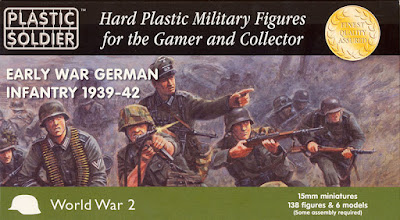These just arrived for me today, a box of PSC's 15mm plastic German infantry for the first half of WWII.
On the box it says "138 figures and 6 models" — I'm not sure to what they refer when they say "models", unless maybe it's the 50mm mortar and anti-tank rifle teams which need to be assembled.
At about 22 quid (roughly forty KiwiBucks at the current rate of exchange) for in the region of 150 figures, they're not bad value. They're a lot cheaper than any metal alternative, as well as being substantially cheaper than Battlefront's plastic offerings in the same scale.
There are twelve sprues in the box, three with command and support personnel, and nine sprues of your regular grunts.
On each of the "grunt" sprues, you get eight riflemen in various poses armed with the Kar98, and two MG34 teams (gunner and loader), one standing, one prone.
The figures are somewhat soft of detail, as is common with injection-moulded plastic, but they're not too bad, and they're satisfyingly chunky compared with some of PSC's earlier offerings. The sculpting is decently round, taking into account the limitations of the medium, and they don't look as flat as some injection-moulded figures do (such as some of the figures from their companion set of early-war support weapons).
The "command" sprues give you a senior officer in a peaked cap, five junior officers and/or NCOs with MP40 submachine guns and other weapons, including one with what appears to be a signal pistol. It also contains components to assemble a 2-man 50mm mortar team, and a 2-man ATR team.
Overall, I like them. The sculpting is good, and there's a lot less multi-part assembly required than I've experienced with some of PSC's other sets, such as their late-war German grenadiers or their Soviet infantry. They look to me like they'll paint up well.
The weapon mix is more suitable for the latter part of the period they're intended for, as there are more MG teams available than would have been present in the campaigns in Poland or France, for example. However, they did soon start to bump up the number of MG34 per section, so I guess it's better to have them supplied than not.
All in all, I'm pretty happy with them.
























